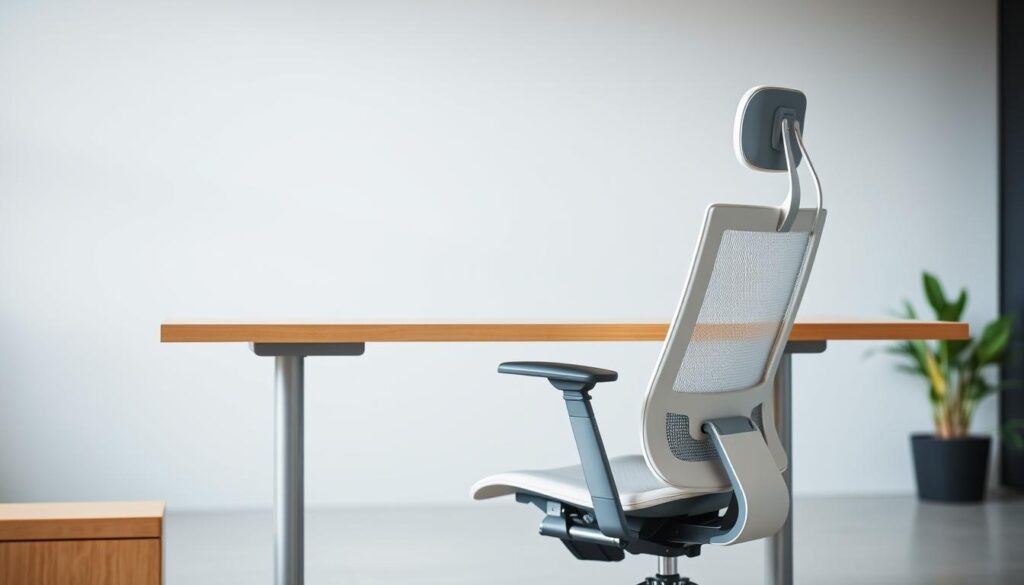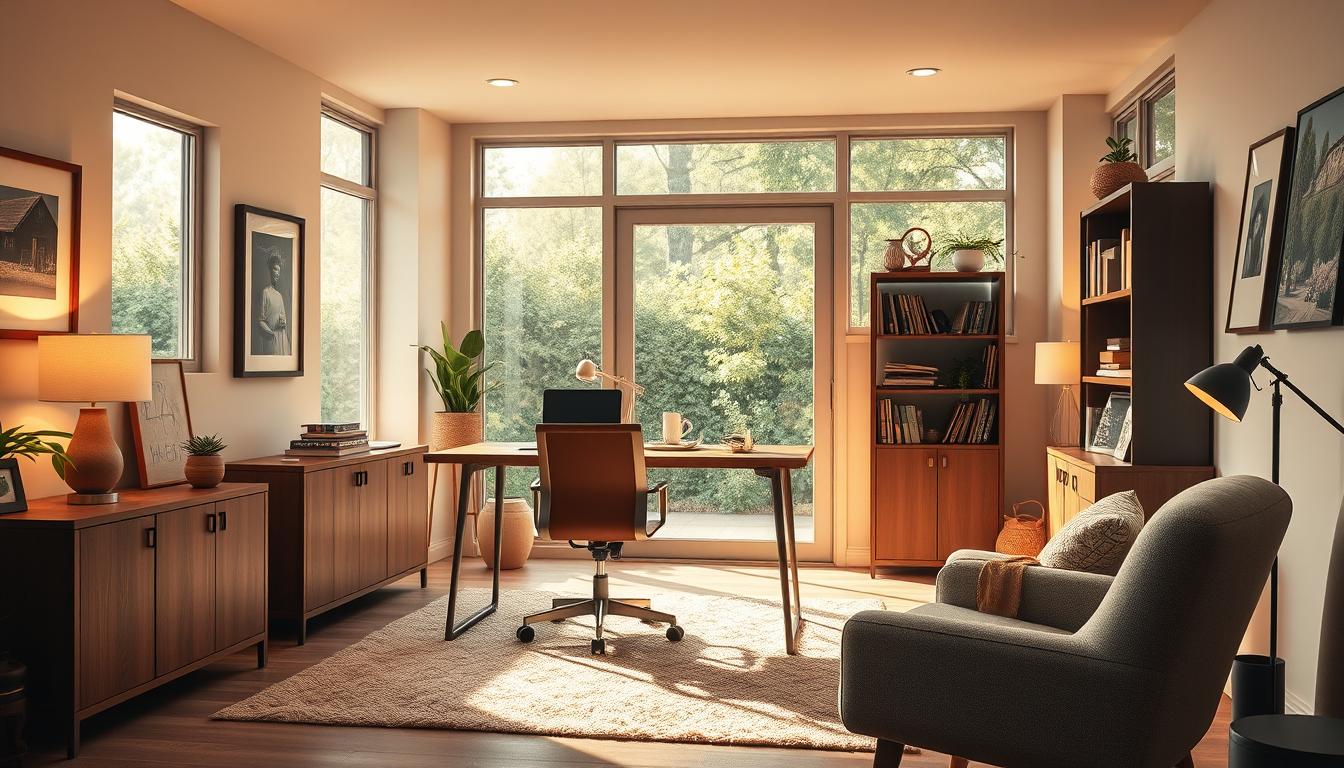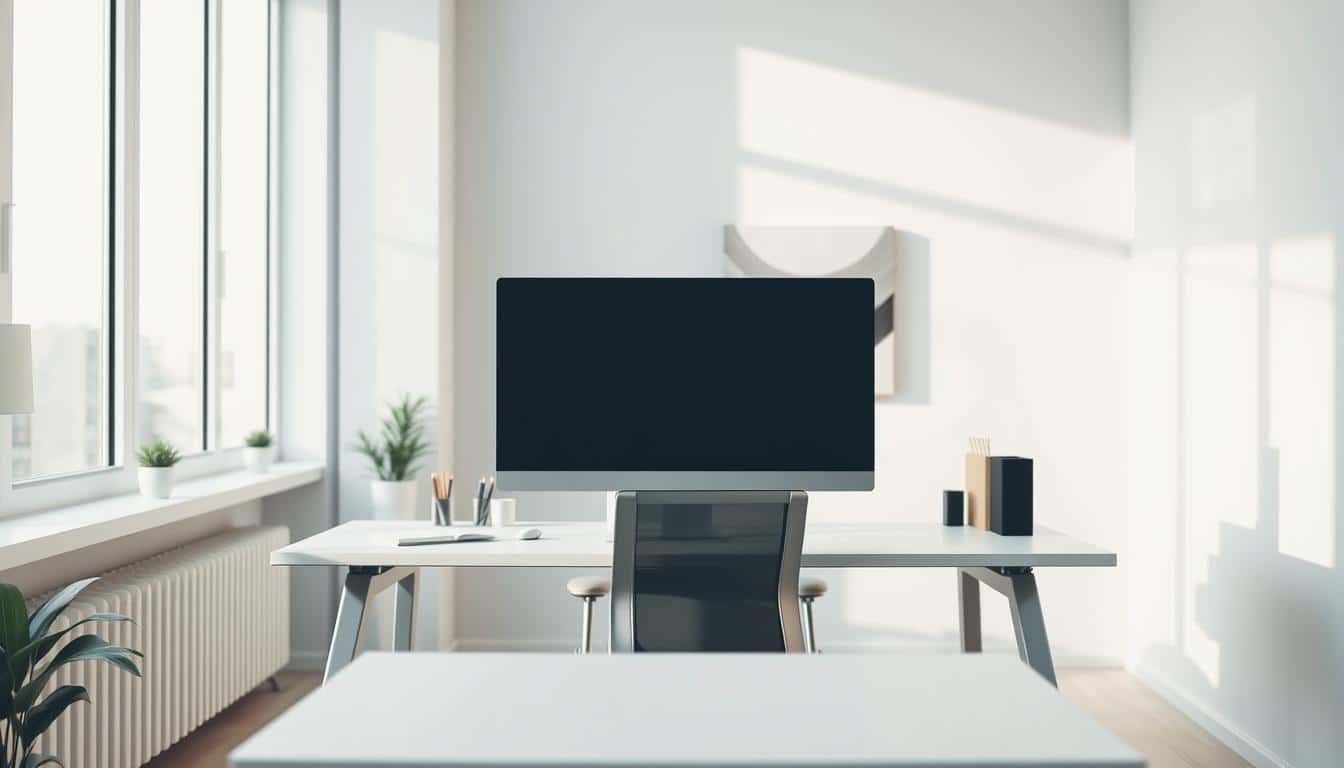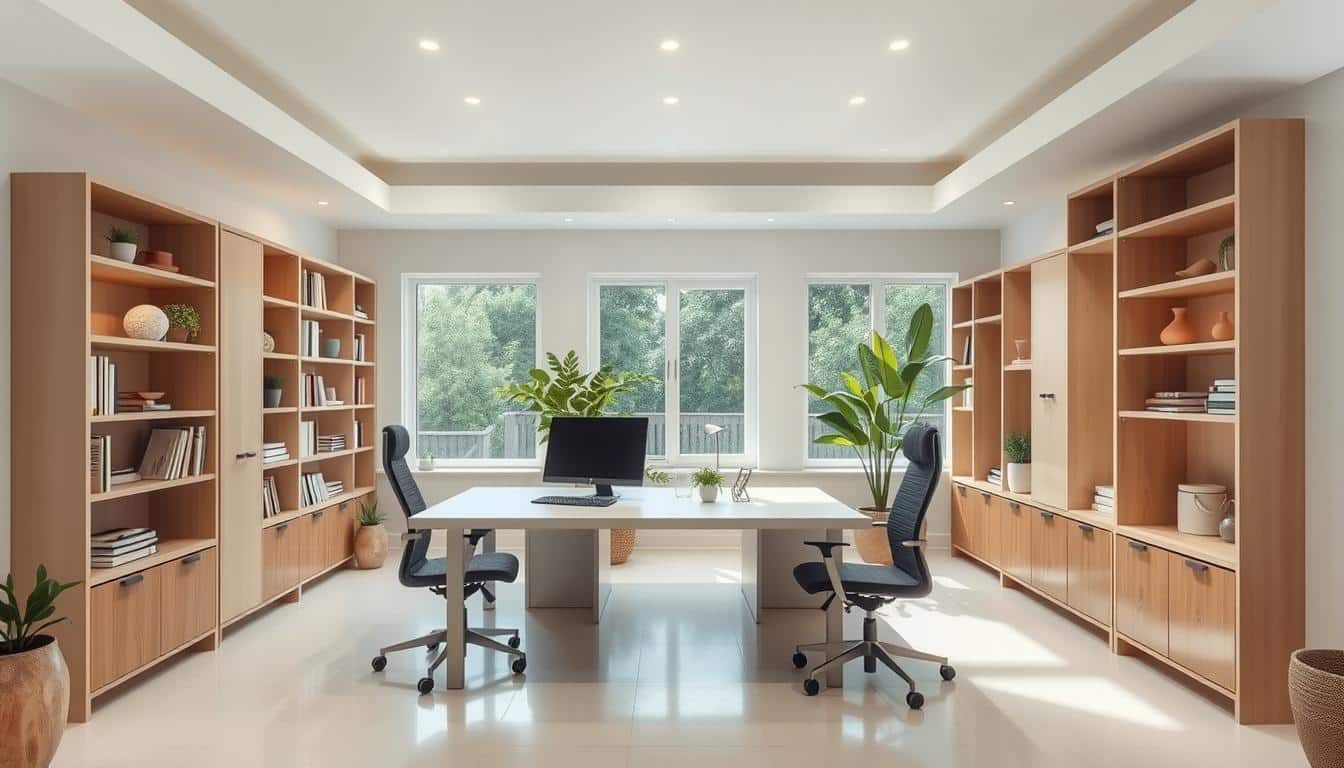In today’s fast-paced work environment, having an ergonomic workspace boosts productivity and comfort. An ergonomic desk helps maintain healthy posture and reduce discomfort. This is key in setting up an effective workstation. Adding an ergonomic desk to your space changes how you work. It prioritizes your health, leading to more efficient and satisfying workdays.
Understanding Ergonomics in the Workplace
Ergonomics makes the workplace fit our needs better. It aims to increase comfort and efficiency at work. Good ergonomics can prevent health problems caused by bad workspace design.
Definition of Ergonomics
Ergonomics is about tailoring our work environment and tasks to fit us better. It reduces the chance of getting hurt and helps us work better. For example, having desks and chairs that adjust to our needs is vital in keeping us focused and healthy at work.
Importance of Ergonomics for Health
Ergonomics plays a big role in keeping us healthy at work. Working in a bad setup can lead to aches and pain, lowering our work quality. Knowing about ergonomics helps companies make workplaces that improve health, make employees happier, and reduce sick days.

The Benefits of an Ergonomic Desk
An ergonomic desk offers many advantages for better workplace comfort and productivity. Many people feel discomfort and pain from sitting too long with bad posture. An ergonomic desk helps reduce these problems, making work healthier.
Reduced Discomfort and Pain
An ergonomic desk’s main advantage is in reducing pain. Workers often suffer from chronic neck and back pain due to poor desk setups. An ergonomic desk provides better body alignment and support. This means less discomfort, helping employees remain productive all day.
Increased Productivity and Focus
Using an ergonomic desk not only cuts down on pain but also boosts productivity. Research shows that with less pain, workers can focus better on their tasks. This leads to more creativity and efficiency, improving overall performance. The benefits of an ergonomic desk can significantly increase success potential for employees.
Key Features of an Ergonomic Desk
Knowing the important parts of an ergonomic desk helps create a better work area. A good ergonomic desk fits individual needs, making sure you are comfortable and productive. This prevents discomfort and makes work more efficient.
Adjustability for Individual Comfort
Adjustability is a key feature of an ergonomic desk. It lets users change the desk’s height and position to match their body size. This helps maintain good posture and lessens back and neck strain. Here are some advantages of having an adjustable desk:
- Height settings match your preference for sitting or standing.
- Movable parts of the desk help avoid reaching and stretching.
- It supports various work styles, keeping you comfortable all day.
Workspace Layout and Design
Your workspace layout is crucial for ergonomic success. An organized workspace means everything you need is within easy reach. This reduces unnecessary movements that could cause discomfort. Here are some things to think about:
- Keep monitors at eye level to avoid neck strain.
- Place keyboards and mice where you can easily reach them to prevent wrist pain.
- Use storage smartly to have important tools handy without clutter.
Setting Up Your Ergonomic Desk Properly
Setting up an ergonomic desk involves careful thought. It enhances comfort and productivity greatly. Achieving the right desk height, proper monitor placement, and correct keyboard setup is key for comfort.
Optimal Desk Height
Desk height is critical for your posture at work. It should let your forearms line up with the ground as you type. Your feet should be flat on the floor, with thighs parallel to the floor for comfort. Adjusting your desk helps avoid muscle and joint strain.
Positioning Your Monitor Correctly
Placing your monitor right is crucial to avoid eye strain and keep good posture. Your monitor should be an arm’s length away. The top should be at or just below eye level. This helps keep your neck balanced and lowers discomfort risk. Move your monitor sometimes to stay comfortable when looking at it for a long time.
Keyboard and Mouse Configuration
Setting up your keyboard right prevents wrist pain. Keep your keyboard and mouse within easy reach. This lets your wrists stay straight and relaxed. Your keyboard should allow your elbows to bend at a 90-degree angle or more. An ergonomic keyboard and a closely placed mouse promote a natural arm posture.
Choosing the Right Chair for Your Ergonomic Desk
Picking the right chair is key for a comfy and effective ergonomic workspace. It should support good posture and boost your work experience. Learning about ergonomic chair features will guide your choice.
Essential Chair Features
Look for these chair attributes:
- Adjustable seat height to match desk height
- Flexible lumbar support for spine’s natural curve
- Comfortable cushioning for long sitting periods
- Adjustable armrests to lessen shoulder strain
- Swivel and movement features for easy mobility
Importance of Lumbar Support
Lumbar support is vital in any ergonomic chair. It keeps the spine aligned, avoiding slouching and discomfort during long work hours. A good chair with lumbar support stops fatigue and promotes better posture.
The right chair height lets your knees stay at or below hip level. This helps in evenly distributing your weight, making you more comfortable.
Creating a Productive Workspace Environment
The place you work in greatly affects your productivity and comfort. By improving lighting, temperature, and noise management, you can make a productive space. This space will help you focus and feel good. Knowing about these aspects lets you create a work area that helps you do your job well.
Lighting Considerations
Good lighting is key for focusing. Natural light is best as it lowers eye stress and boosts your mood. If there’s no natural light, use desk lamps that can change brightness to feel like daylight. This makes a space where you can see well and stay energized.
Temperature Control in the Office
Keeping a comfy temperature helps keep you productive. A place that’s too hot or too cold can make you lose focus and feel tired. Try to keep the temperature between 68°F and 72°F. Using air conditioning, fans, or heaters can help keep the focus and energy up all day.
Minimizing Noise Distractions
Noisy distractions can break your concentration. To make a workspace where you can work well, reducing noise is key. Think about getting noise-canceling headphones, using soft furniture that lessens sound, or white noise machines. These methods lower background noise, letting you work without disruption.
How to Maintain a Healthy Posture
Keeping a healthy posture is key for anyone who sits at a desk for hours. The right way to sit can cut down on body strain and help you feel better overall. It’s also critical to take breaks to move around. This helps ease tension and refresh your muscles during the day.
Posture Tips While Sitting
Here are some tips to better your posture while sitting:
- Keep your feet flat on the ground to support stability.
- Ensure your back is firmly against the chair for good lumbar support.
- Adjust your chair height so that your knees are at a right angle.
- Position your monitor at eye level to avoid neck strain.
- Maintain relaxed shoulders to prevent upper body tension.
Importance of Movement Breaks
Taking breaks to move is crucial to fight the downsides of sitting too long. These breaks boost blood flow and reduce muscle stiffness. Try to take a break every hour, doing some light stretches or standing exercises. Just a few minutes moving can greatly increase focus and energy, helping both your mind and body.
Integrating Technology with Ergonomic Design
Adding ergonomic tech to your work area boosts comfort and work output. Using ergonomic keyboards and mice lessens wrist pain and betters your typing stance. Adjustable stands for monitors help get your screen just right, avoiding neck pain. This creates a better work setting.
Using Ergonomic Keyboards and Mice
Ergonomic keyboards help keep hands and wrists in a natural spot. This cuts down on discomfort when typing for a long time. With ergonomic mice, they make your workflow smoother and prevent injuries from doing the same motions over and over. Getting these ergonomic tools makes your workspace healthier.
Employing Monitor Stands and Risers
Monitor stands are key for the right eye level and less neck pain. By adjusting your monitor’s height, you match it with your sight line. This makes sitting more comfortable. These tools don’t just increase comfort, they also help you focus better and get more done.
Other Ergonomic Accessories to Consider
Besides an ergonomic desk and chair, there are other accessories that can make your office more comfortable and help you work better. Footrests and wrist rests give extra support which is really helpful. Also, having plants around makes your workspace look and feel nicer.
Footrests and Wrist Rests
Footrests are great for keeping your legs in the right position. They help your blood flow better and take some pressure off your back when you’re sitting for a long time. Wrist rests are just as important because they prevent soreness from typing all day. They keep your wrists from getting strained by giving them a soft place to rest.
Desk Plants for Enhancing Focus
Adding plants to your office does more than just make it look good. They actually help you feel less stressed and more focused on your work. Plants like snake plants or pothos don’t need a lot of care, but they do a great job of cleaning the air. Your office isn’t just ergonomic with these plants, it’s also a nicer place to be.
Conclusion
As we’ve discussed, getting an ergonomic desk is key for your comfort and doing better at work. An ergonomic desk lets you adjust it for a better posture. This not only makes you more comfortable but also helps you do better in your job.
Making your desk and chair better for your body is a big step towards a healthier work life. These upgrades can help you do well in your job over time. They create a place where you feel good and work well.
So, having an ergonomic workspace is about more than just looking good or feeling cozy. It’s about choosing wisely to improve your health and work better. Make these changes to reach your highest potential and have a happier work life.



